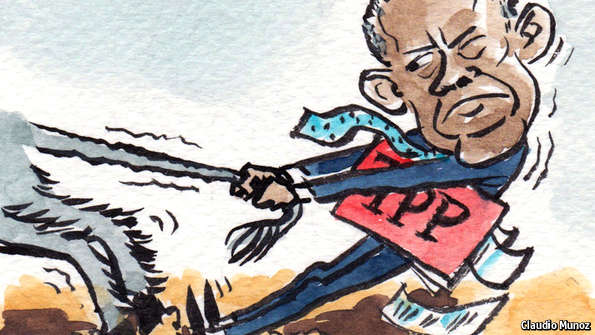
On July 31, America and the other 11 member countries of the Trans-Pacific Partnership (TTP) ended three days of tense negotiations. All sides have been unable to reach a consensus on a web of issues including intellectual property rights and access to agricultural markets. The U.S. has kept member countries in marathon negotiations, but to no avail. However, the negotiations are showing signs of progress and appear to be focusing on the “finishing touches.” There are still two major obstacles to the deal: opposition in the U.S. Congress and issues concerning agricultural products in Japan. The former has already been basically resolved and there appears to be progress on the latter, which will help solve the issues with Japan. It looks as though this year, or at the latest, early next year, the TPP negotiations will be completed. A new trans-Pacific regional free trade institution will officially come into being.
The original members of the TPP were Chile, Brunei, Singapore and New Zealand, which, in 2005, began negotiations and were able to produce and sign a free trade area-style economic and trade agreement. Later, America found that it would be advantageous to join this agreement, and in 2008, entered into discussions, later becoming the driver of negotiations. America took the lead to expand the plan, bringing in Japan, Canada, Vietnam, Malaysia and other countries to broaden the group to 12 members. The TPP would have its own rules for joining, based on the absolute acceptance of free trade. This agreement would break free from the traditional framework for free trade agreements to create the 21st century’s first high standard, comprehensive free trade agreement. It would touch upon labor, environmental protection, intellectual property rights, investment resolution mechanisms, infrastructure and government procurement rules, as well as other areas.
America’s high standard agreement, under broad leadership, has met a number of problems in each of the member countries, causing negotiations to drag on. Reaching an agreement will require each country to weigh the pros and cons, as well as make compromises. In the end, however, the agreement will reflect the thinking of American policy. If the agreement can be reached, it will be a major piece of Obama’s legacy.
America’s pushing of the TPP and the political and economic evolution of the Asia-Pacific and East Asian regions are closely connected. East Asia has already become the major economic center of the world. It is now the largest market, the fastest developing, and the market that is most full of vitality and potential. As America’s influence has declined, so has its market share, which now lags behind China.
A free trade region between the nations of East Asia is developing — one agreement of note is the free trade area between China and ASEAN, which doesn’t include the United States. To restore its old position, America has pushed the TPP to achieve several goals at once. America aims to increase its exports, maintain involvement in the integration of East Asia, and to maintain its position in the geo-economic, geopolitical and safety issues of the region. To this end, America seeks to hold to the rule establishing authority for 21st century global free trade agreements.
Therefore, America has pushed forward on TPP negotiations with great vigor, to the point of making great “sacrifices.” If America compromises too much in negotiations, especially with regard to the demands of Vietnam and other developing countries, then there will be a transfer of benefits to these countries. According to figures from an authoritative American research institute’s 2014 report, the TPP will only add .4 percent to annual per capita income for Americans, compared to an increase of 14 percent for the Vietnamese.
To establish the TPP, America has invested a large amount of political, economic and diplomatic resources that are not commensurate with the gains to be had. This shows that the real motives for America’s actions are political and strategic, and can be thus called 30 percent economic and 70 percent political. The real goal is for America to occupy the top position in a unified Asia-Pacific region, and to re-establish its dominant and unrivaled leadership position in this strategically important region, and ultimately maintain its dominant position as the world’s only superpower. Even more important is the fact that reaching a final TPP agreement is a critical element of the United States’ “pivot to Asia,” and its plan to act as a buffer and inhibit the rise of China. America has brought countries which have territorial disputes with China and ASEAN, such as Japan and Vietnam, into TPP discussions, clearly in a bid to counter China. It is no wonder that some media sources have labeled the TPP an “economic NATO.” America has inserted stipulations with regard to government procurement to hold back China’s move to establish the Asia Investment and Infrastructure Bank. Recently, President Obama said, “If we don’t establish the rules for global free trade, then China will.” These words show that America is pushing the TPP not for the economic benefit of member states, but to inhibit the rise of China.
If the TPP negotiations take longer and become drawn out, America may revisit its thinking. America has not invited China to join the TPP and has effectively shut out China and thus politicized the TPP. America is using the TPP has a tool to curb the rise of China, which will hurt the U.S., China and the TPP in the end. The U.S. should reverse its thinking and position, and turn these “three losses” into “three wins.”

The U.S. welcomes China’s rise. But China is scaring everyone with their aggressive actions in support of their vast territorial claims and their refusal to negotiate with the other countries involved.